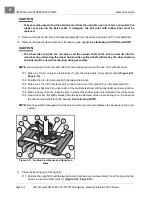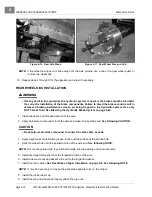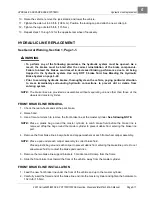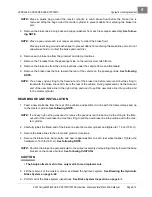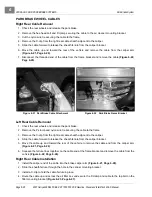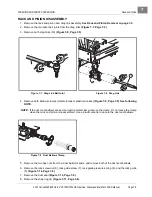
HYDRAULIC AND PARK BRAKE SYSTEMS
Bleeding the Hydraulic Brake System
Page 6-22
2007 Carryall 295/295 SE & XRT 1550/1550 SE Gasoline, Diesel and IntelliTach M & S Manual
6
2. Loosen the jam nut on the push rod clevis and secure the clevis to the brake pedal with a clevis pin and
rue pin
(Figure 6-20, Page 6-21)
.
3. Carefully secure the front and rear brake line flare fittings to the master cylinder. Finger-tighten the hard-
ware.
4. Use a flare-nut wrench to tighten the brake line fittings to 11 ft-lb (15 N·m).
5. Secure the reservoir hoses to the master cylinder barbed connectors.
See following NOTE.
NOTE:
The front port on the master cylinder should be attached to the driver side port on the reservoir.
Do not allow these hoses to develop kinks or to be routed in such a way as to restrict gravity fluid
flow.
6. Fill the reservoir with brake fluid specified for this vehicle and bleed the hydraulic brake system.
See
Bleeding the Hydraulic Brake System on page 6-22.
7. Adjust the brake pedal stroke with the clevis and master cylinder push rod threaded connection. Tighten
the jam nut to 14 ft-lb (19 N·m).
See Brake Pedal Adjustment, Section 5, Page 5-4.
8. Inspect the brake system.
See Brake System Inspection on page 6-1.
BLEEDING THE HYDRAULIC BRAKE SYSTEM
See General Warning, Section 1, Page 1-1.
ý
WARNING
• Do not bleed the brakes in the same manner as a DOT 3 system. Failure to bleed the brakes as
instructed in this manual will result in decreased braking performance due to air being
trapped in the hydraulic system.
• Use only DOT 5 brake fluid to fill the master cylinder. NEVER mix DOT 3, DOT 4, or DOT 5.1
with DOT 5 as it IS NOT compatible.
The hydraulic system must be free of air. Air enters the hydraulic system whenever the system is opened and
will result in a “spongy” brake pedal.
The master cylinder controls two separate hydraulic sub-systems. The front two wheels are connected to the
front portion of the master cylinder and the rear wheels to the rear portion. One or both sub-systems may
require bleeding, depending on where the hydraulic system was opened.
Pressure or vacuum bleeding, with preference given to the pressure bleeding method, is the recommended
way to remove air from a brake system filled with DOT 5 silicone brake fluid. If a pressure or vacuum brake
bleeding tool is not available, manually bleeding the system can be accomplished when done carefully.
BLEEDING BRAKES ON A DOT 5 FLUID FILLED SYSTEM
1. Remove all cargo from the cargo bed in preparation for lifting the vehicle. Turn the key switch OFF and
remove the key. Place the Forward/Reverse handle in NEUTRAL.
2. Check the brake pedal and master cylinder push rod for proper adjustment before the brake system is
bled.
See Brake Pedal Adjustment, Section 5, Page 5-4.
3. Remove the cap from the master cylinder reservoir and top off the master cylinder with fresh DOT 5 sil-
icone brake fluid.
NEVER
mix DOT 3, DOT 4, or DOT 5.1 with DOT 5 as it
IS NOT
compatible.
Summary of Contents for IntelliTach XRT 1550
Page 2: ......
Page 22: ...1...
Page 54: ...4...
Page 60: ...5...
Page 90: ...6...
Page 114: ...8...
Page 118: ...9...
Page 196: ...11A...
Page 290: ...11C...
Page 468: ...13C...
Page 490: ...14...
Page 498: ...15...
Page 548: ...16...
Page 560: ...Club Car R NOTES...
Page 561: ...Club Car R NOTES...
Page 562: ...Club Car R NOTES...
Page 563: ......





